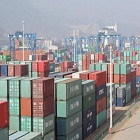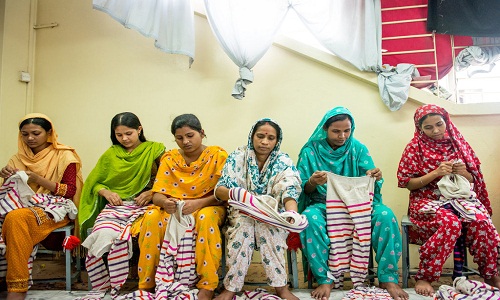FW
"The post-Brexit Bangladesh economy will face a low export growth due to subdued demand especially for RMG caused by weaker currencies in the UK and the EU zones. Negotiations are taking place but British dream of comprehensive free trade with Commonwealth would be much farther away and far less attractive to Commonwealth countries."

The post-Brexit Bangladesh economy will face a low export growth due to subdued demand especially for RMG caused by weaker currencies in the UK and the EU zones. Negotiations are taking place but British dream of comprehensive free trade with Commonwealth would be much farther away and far less attractive to Commonwealth countries.

'Brexit', does not simply refer to exit, rather it should be seen as 'entering' into an era of uncertainty about future relationship with the UK and EU and the rest of beneficiaries countries, thus greatly affecting the economies which are intertwined or have major trade relationship with either or both parties. There should ultimately be fiduciary, operational, and strategic perspectives to implement the exit. Bangladesh faces uncertainties considering the future outlook of exports and imports to the UK and the EU. The EU, as a bloc, is the largest importer of Bangladeshi products of which the UK constitutes about 10 per cent as a single country, being the third after the US and Germany. The total export volume from Bangladesh to the UK during the FY 2015-16 was valued at $3.2 billion. The main export items are: knitwear, woven garments, engineering products, frozen food, leather etc. Readymade garments constitute nearly 90 per cent of the total export at $2.90 billion which is about 12 per cent of global RMG export of Bangladesh.
The devaluation of pound has already implied severe pressure on Bangladeshi exporters as net profit margin has already been squeezed due to increase in operational and compliance costs. The consequences have been so explicit that the Overseas Development Institute (ODI), a London-based think-tank on international development issues, has said lower value of the pound and lower UK growth will reduce imports in the short-term.
The fall of pound enables countries to gain from import and its benefit can be reaped off. On the contrary, the appreciation of euro against pound has made imports from countries like Italy, Germany, France, costlier. Increase in inflation which was 0.6 per cent in August, the highest since November, 2014 also affecting the real purchasing power of the British consumers.
Cost of losing access to the single market
The major threat that comes with uncertainty is whether Bangladesh will enjoy 'GSP' or EBA scheme which grants duty- and quota-free access to all products, except arms and ammunitions, covering 99 per cent of all tariff lines. As implementation of Brexit by the British and the EU authorities will be in the coming two years, it will determine their tangled trade relations like the single market facility or performance like European Free Trade Association. If Britain exits leaving the single market facility, then companies like Primark, M&S, Asda, Newlook and others will face tariff charges in EU, resulting in higher prices and lower demand, eventually leading to lower import from Bangladesh. These raise questions whether the $5.0 billion garment export target by 2021 in the British market will be possible. Moreover uncertainty and volatility in the British market is likely to have adverse impact on its investment bound for Bangladesh.
A more tailored policy is required To counter the Brexit effect Bangladesh needs some precautionary measures. The government should form a support fund/subsidiary to counter the immediate exchange rate loss and should pay attention to bilateral relations as out of the EU, Britain will also look to reform its international relations. It should also consider what will happen if more EU countries want to leave the union following the Brexit. As a LDC, Bangladesh government is now required to play a vigorous role to uphold trade interests and maintain relations with trade bodies in Britain. The central bank may also intervene to keep up the value of pound against taka to support the exporters. The exporters and their associations should start to recognise geopolitical risks and formulate long-term business strategies. They should also explore new markets and different channels. The RMG sector needs to explore new markets with additional basket of export products.
With upward increase of garment, Bangladesh’s overall exports to the US rose 1.12 per cent to $3.6 billion in the first seven months of this year, reveals data from the US Department of Commerce. Between January and July, manufacturers exported $3.36 billion of garment products to the US that happens to be Bangladesh's single largest export destination. This denotes a year-on-year rise of 0.87 per cent.
Although the growth of apparel exports to the US is not too high, the trend is still inspiring. China has been losing its market share in the US. This is another major reason for the higher growth of Bangladesh's garment exports to the US, it is assumed. Of the top 10 garment exporters to the US, only Bangladesh and Vietnam showed positive trends in the shipments during the period. Vietnam's exports grew 1.83 per cent to $6.51 billion in the first seven months.
Between January and July, the US import of garment items from the world declined 4.98 per cent to $60.23 billion from $63.39 billion last year. During this time, China's exports declined by 8.49 per cent to $21.39 billion, India’s by 0.97 per cent to $4.39 billion and Pakistan by 10.67 per cent to $1.59 billion.
This year’s autumn edition of Chic, one of Asia’s leading fashion trade show will be held at the National Exhibition and Convention Centre, Shanghai from October 11 to 13. Chic offers the right date and choice of fashion brands from all over the world. Messe Düsseldorf is the organiser for the joint company exhibition Federal Republic of Germany. The presentation-style is that of department store with a fashion mix of women’s and men’s clothing, body wear, bags, shoes, scarves and shawls on display. Also on display would be collections for Spring/Summer 2017.
In addition to international presentations from Italy, France, Germany, Brazil and others, Pure Shanghai will be also there as a ‘show-in-show’. Also present will be Korean Preview in China and the shoe sector GOFL, organized by the Kaishi Exhibition Group.
With a spotlight on innovation and start up’ young designers from 33 fashion schools will have the opportunity to present their work and ideas in a unique context. Chic has been taking place for the last 24 years. Launched in autumn last year, the Autumn Chic show offers two editions a year with a comprehensive overview of Chinese and international brands.
The Caribbean Export Development Agency teamed up with the Centre for the Facilitation of Investment of Haiti (CFI) and the Centre for the Promotion of Export and Investment of the Dominican Republic (CEI-RD) for the Sourcing at Magic 2016 fair held in Las Vegas, Nevada from August 14-17. This exercise was done within the framework of the 10th European Development Fund (EDF) Haiti-Dominican Republic Bi-national Programme.
Termed as North America’s largest and most comprehensive apparel sourcing event that connects the entire global supply chain of the fashion industry, Sourcing at Magic was the ideal occasion for Haiti and Dominican Republic to increase visibility for their textile and apparel sector as well as build awareness about trade and investment opportunities available in both countries.
This activity was also a part of the implementation of the Joint Investment Promotion Strategy (JIPS) which was developed to attract Foreign Direct Investment (FDI) and facilitate diversification into value-added production of fashion accessories. Visitors were introduced to the unique and creative forms of garments available to them from the Haitian and the Dominican textile and apparel industry, thereby enabling the CFI and CEI-RD to explore new business opportunities and engagement with potential investors, particularly from the United States and Latin America.
This mission also served to strengthen the links and collaboration with the Dominican Association of Chacabanas and hence contributing to the promotion of this high value added product from the Caribbean in representation of the Caribbean.
"Textile sustainability has been gaining traction lately and putting a lot of pressure on fashion companies to take sustainable route. While some go by standards organisations like GOTS or ISO, to learn more about the supply chains of their favourite brands, we still don’t have scientific evidence to show exactly where a garment has come from. If a technology was developed to do this, it would quickly impact the level of sustainability within the fashion industry, and would quickly percolate among other industries as well."

Textile sustainability has been gaining traction lately and putting a lot of pressure on fashion companies to take sustainable route. While some go by standards organisations like GOTS or ISO, to learn more about the supply chains of their favourite brands, we still don’t have scientific evidence to show exactly where a garment has come from. If a technology was developed to do this, it would quickly impact the level of sustainability within the fashion industry, and would quickly percolate among other industries as well. Imagine a Fiber Testing Kit, that any consumer could purchase, bring home to their closet, and run a quick analysis on their favourite T-shirt. Anyone with the ability to test the fibre, theoretically, could hold companies accountable for their sourcing practices. An invention like this could be highly disruptive to the fashion industry.
Time tested methods

Around 40 years back, DNA profiling was developed by British-born Sir Alec Jeffreys, a geneticist and professor at the University of Leicester. In California, biochemist Kary Mullis, learned how to link and repeat DNA (polymerase chain reaction or PCR), while trying to find the point of genetic mutations for hereditary diseases. Both extraordinary minds made incredible breakthroughs for our knowledge and understanding of the human genome. DNA testing was implemented into law enforcement’s forensic teams within two years of the discoveries and has since been used worldwide to prove criminal acts, as well as exonerate innocent suspects.
Many fibres are traceable through the forensic analysis. Once analysts determine if the thread is natural, manufactured, or mixed, they can usually identify the product it came from – a rug; a sweater. This is again often used by law enforcement and prosecutors to seek justice for crimes. Fibre forensic analysis is usually debated in court due to the mass of products created. The amount of production of a particular manufactured fibre and its end use, influence the degree of rarity of a given fibre. Unlike a fingerprint, there is no way to tell two fibres of the same origin apart. Fibre forensics can only be used as evidentiary support to corroborate other facts. Still this technology hasn’t been quite successful.
Molecular Tagging
In a world of ever-growing technological advancements, this could be a logical next step in ensuring more sustainable supply chains. Molecular tagging of genes can identify and verify products creating a forensic proof of origin for more sustainable fashion. It tags fibres by matching batches to origins already known. Once a supplier is tested and proven to be sustainable, SigNature(™)T technology can then continue to tag future batches. Although this gene tagging method may not be able to track individual fibres from anywhere in the world yet, many sustainable fashion organisations have mapped out the production process for consumers.
Organisational efforts
Made-by, a non-profit organisation dedicated to the fashion industry’s environmental and social conditions, has laid out a seed-to-shelf roadmap. Made-By works with sustainable brands to standardise the production process, and mainstream sustainability advancements. Over 50 industry experts consulted on the typical methods, and six large fashion brands have now joined, including G-Star and Ted Baker. The organisation is creating an awareness among consumers to learn more about the manufacturing side of where their garments come from. The fibre testing system could back up these organisations’ endeavours by proving their process is safe, environmental, and sustainable.
A team of researchers at Stanford University has developed skin-like fabric that cools the body more efficiently. In the latest edition of Science journal, researchers have reported they used nanoporous polyethylene to develop a textile material that aides radiative cooling while maintaining breathability, wicking and necessary mechanical strength. According They have also devised an instrument to simulate skin temperature. The use of nanoporous polyethylene fabric resulted in the lowering of skin temperature by about 2.7 degree centigrade when compared with another commonly used next-to-skin fabric. The fabric effectively cools the person which makes cooling the building unnecessary thereby saving energy.
Nanoporous plastic textile moves the body heat as infrared rays due to the nanostructured polyethylene. Researchers modified the polyethylene material that is commonly used in battery development which enables it to be opaque to visible light but transparent to infrared rays so that the heat can be dissipated. To Shanhui Fan, Professor of electrical engineering at Stanford University, who co-authored the study, says this research can lead to the development of new materials that can trap or let go infrared radiations.
With mounting opposition, US President Barack Obama is desperately trying to pass the Trans-Pacific Partnership (TPP) trade deal before his term ends in 2017. Both major party presidential nominees, former Secretary of State Hillary Clinton and Donald Trump have publicly stated that they would not sign the agreement if they become president. Though opposition to TPP has typically focused on the threat of losing American jobs, another concern that is being seen is the loss of sovereignty through a byzantine process known as investor-state dispute settlement (ISDS).
ISDS allows companies to sue states using private, three-man corporate tribunals as judges. The corporate tribunal process was originally intended to protect corporations from having their property nationalized by foreign countries. By allowing companies to recover lost funds, it was thought, states would be less likely to nationalize foreign assets. As a result, foreign investment would increase into countries in desperate need of it.
Under current practice, ISDS has become a means for transnational corporations to pressure governments to change health and safety regulations and let corporate executives walk on criminal charges. According to a recent study of the ISDS process, the system was designed to deal primarily with theft by autocrats, but, in the majority of cases today, businesses are suing democracies for enacting regulations. The Agency also found instances in Egypt, El Salvador and Indonesia where the threat of ISDS actions by a business led to criminal charges being dropped against company executives.
The ongoing trend of seasonless apparel does not exclude denim. From August 30 to 31, global mills exhibited a combination of core products along with a huge quantity of brand new washes and blends for S/S 18 at Bluezone, the denim section of Munich Fabric Start.
It was of mix show’s at the ‘keyhouse’ with a full house of fiber, technology and chemical companies that came together to offer the denim market seasonless solutions to do better business. YKK product designer Ina Kaiser said that winter is not cold and summer is not hot. There’s no more light colors for spring, dark colors for winter mentality. Apparel collections don’t drastically change from season to season. At Munich Fabric Start, the trims company showcased it’s A/W 17-18 range.
Kaiser explained that the call for seasonless or transitional, looks is getting into trims as well. In women’s apparels, accessories are light and pastel (mint, pink, lavender) with a hint of luminosity through opalescent and iridescent finishes. The theme is pretty for spring or dreamy for winter. Badges are at the forefront of men’s trims, with many manufacturers focusing on scouting and camping motifs—a concept that ties together nicely with autumnal color ways and summer brights.
With patchwork and DIY details expected to remain popular in denim, YKK is a collection of items inspired by retro haberdashery. For women, rivets are made to resemble 4-hole buttons. Patches of embossed leather are sewn onto the tops of frontier pockets, and funnel-shaped buttons and flat buttons are brushed with warm vintage yellow and green.
Shiny copper rivets, zippers and buttons add a jewelry-like effect to women’s. Tiny rivets and miniature bees are used for decorative items. Letters of the alphabet are reworked as rivets. The monogram theme is carried into belt loop ornaments that can be sewed.
India saw a decline in exports of woolen yarn, fabric and made-ups by 48 per cent and woolen garments by nine per cent in the first quarter of the current financial year. Demand for woolen garments has been falling due to global warming as well as sluggish orders from Europe. The price of 20.5 micron wool has risen to Rs 800 or Rs 900 from Rs 600 or Rs 700 a kilo two years ago. However, manufacturers find it difficult to pass this on to consumers because it might further affect demand.
India depends on imported wool from Australia for making garments and shawls. Domestic wool is used for blankets and rugs. Large firms catering to niche markets have been able to beat the slowdown in demand with the help of innovation and marketing strategies but medium and small players are gasping for breath.
During pre-winter months, wool fabric is in high demand by the Kashmiri artisans, who make embroidered garments. But business of mid-size manufacturers in Ludhiana and Amritsar has been hit by the turbulence in Kashmir. This year they have had to run their factories at one-third capacity. The unrest in the Kashmir Valley has wiped out nearly 50 per cent of domestic demand.
A $30 million dollar expansion at Invista’s fiber manufacturing plant in South Carolina will enable the company to rapidly respond to small-lot, carpet fiber demands. The investment represents the industry’s first-ever offering of one-step, small-lot capability specifically for solution-dyed nylon 6,6.
Mill customers and the design community rely on Invista to offer a palette of hundreds of solution-dyed nylon 6,6 colors for each of their unique design preferences. The new technology will expand Invista’s capability to offer sophisticated color families while at the same time improving service.
Invista developed the innovative, proprietary small-lot technology by working closely with equipment manufacturer Truetzschler, which will supply Invista with the highest quality of BCF extrusion technology for this important expansion.
The variety of small-lot nylon 6,6 fibers will initially be offered under Invista’s Antron Lumena brand to serve the global, growing solution-dyed nylon BCF markets.
US-based Invista, is one of the world's largest integrated producers of intermediate chemical products, polymers and fibers, primarily for nylon, spandex and polyester applications. Invista is the owner of the brands Lycra, Coolmax, Cordura, Stainmaster and Antron. The company’s cutting-edge nylon, spandex and polyester technologies are used to manufacture apparel, carpets, automobile components and other products.












